exhibition
19 June 2019 > 12 January 2020
Maria Lai. Tenendo per mano il sole
#MariaLai
opening hours
Monday closed
Tuesday to Sunday 11 am – 7 pm
EARLY TICKET OFFICE CLOSURES
Saturday and Sunday last entry at 5:30 pm
Monday closed
Tuesday to Sunday 11 am – 7 pm
EARLY TICKET OFFICE CLOSURES
Saturday and Sunday last entry at 5:30 pm
for young people aged between 18 and 25 (not yet turned 25);
for groups of 15 people or more; registered journalists with a valid ID card; La Galleria Nazionale, Museo Ebraico di Roma ticket holders; upon presentation of ID card or badge: Accademia Costume & Moda, Accademia Fotografica, Biblioteche di Roma, Centro Sperimentale di Cinematografia, Enel (for badge holder and accompanying person), FAI – Fondo Ambiente Italiano, Feltrinelli, IN/ARCH – Istituto Nazionale di Architettura, Sapienza Università di Roma, LAZIOcrea, Palazzo delle Esposizioni, Amici di Palazzo Strozzi, Accademia Nazionale di Santa Cecilia, Scuola Internazionale di Comics, Teatro Olimpico, Teatro dell’Opera di Roma, Teatro di Roma, Università degli Studi di Roma Tor Vergata, Youthcard
valid for one year from the date of purchase
minors under 18 years of age; disabled people requiring companion; EU Disability Card holders and accompanying person; MiC employees; European Union tour guides and tour guides, licensed (ref. Circular n.20/2016 DG-Museums); 1 teacher for every 10 students; ICOM members; AMACI members; journalists (who can prove their business activity); myMAXXI membership cardholders; European Union students and university researchers in Art and Architecture, public fine arts academies (AFAM registered) students and Temple University Rome Campus students from Tuesday to Friday (excluding holidays); IED – Istituto Europeo di Design professors, NABA – Nuova Accademia di Belle Arti professors, RUFA – Rome University of Fine Arts professors; upon presentation of ID card or badge – valid for two: Collezione Peggy Guggenheim a Venezia, Castello di Rivoli Museo d’Arte Contemporanea, Sotheby’s Preferred, MEP – Maison Européenne de la Photographie; on your birthday presenting an identity document
MAXXI’s Collection of Art and Architecture represents the founding element of the museum and defines its identity. Since October 2015, it has been on display with different arrangements of works.

Monday closed
Tuesday to Sunday 11 am – 7 pm
EARLY TICKET OFFICE CLOSURES
Saturday and Sunday last entry at 5:30 pm

Foto © Musacchio, Ianniello & Pasqualini
A large selection of Looms, a group of works that, starting from the mid-1960s, involved Maria Lai in her research into everyday materials, either salvaged or derived from Sardinian tradition, conceived as the artist’s shifting away from the previous phase which was more clearly inspired by Modernism. In Looms, the thread begins to appear as a preponderant element, material and concept of the work at the same time. Akin to the way the artist’s life and research are crossed by a desire to link together distant elements, the work is a connecting “thread” that can restitch the meaning of things. The Loom joins this reflection with that of the warp: a basic scheme on which to elaborate endless variations. For this artist, these works, along with the Sewn Cloths that came later, became a metaphor for an existence aimed at finding the potential for a relationship between the inner self and the outside world in art. Essere è tessere, the title of the large-scale collective action conceived for the town of Aggius in 2008, is an interior dictation that crosses all the artist’s research strands and ties them together in a single, large work, weaving the world together.
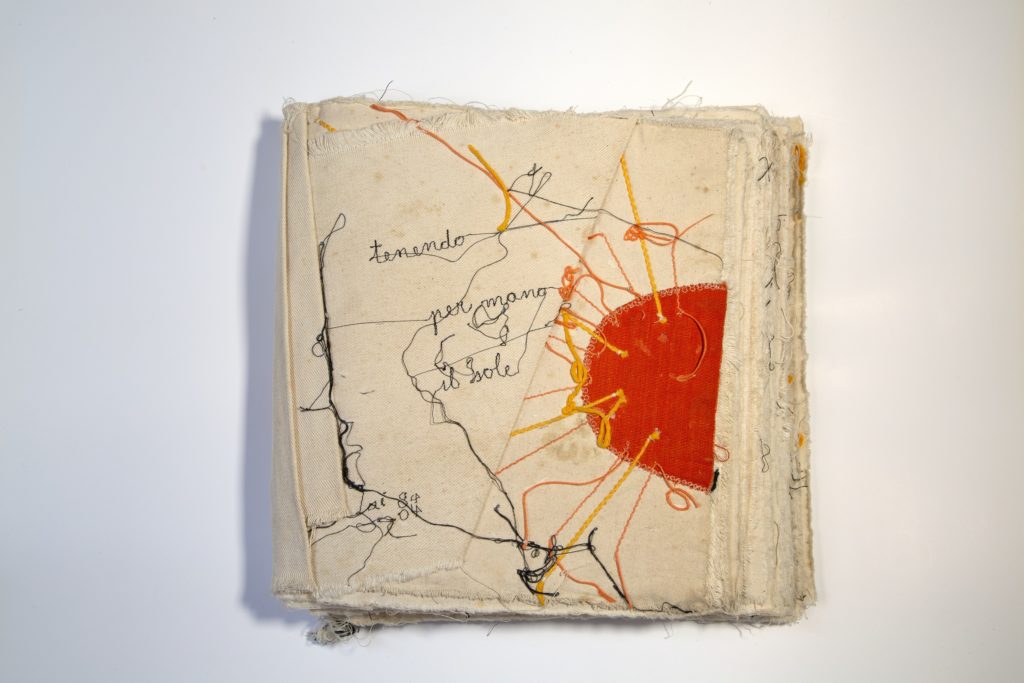
Tenendo per mano il sole, 1984-2004 | filo, stoffa, velluto, cm 33 x 63 | Collezione privata | Photo credit Francesco Casu | Courtesy Archivio Maria Lai © Archivio Maria Lai by SIAE 2019
Works that are apparently very different from each other, often conceived as fully-fledged games, sharing the desire to arouse in the beholder and the user a renewed sense of intimacy with respect to the work of art. Through this particular research, the artist calls back into question the potential of the imagination as the grounds for every process of learning and knowledge. As Maria Lai stated in 1994, underscoring the distance between this research and the child’s environment, “art is adult’s play”, an invitation to re-examine one’s insecurities and call back into play the creative possibilities that one no longer remembers. In the early 1980s, Maria Lai conceived the first Sewn Fairy Tales, works that she would continue to make until the 1990s in parallel with her Sewn Books. Thanks to a re-reading of popular Sardinian tales or ones she invented on her own, the artist developed a world of characters that live in complex situations and adventures, eventually finding an ultimate path to salvation. The fairy tales, later produced in a printed edition, are open to being interpreted freely: Lai herself used video animations, conceived with the director Francesco Casu, in order to offer a different and equally valid reading each time. This total openness to the public’s interpretation becomes evident in the designing of the playing cards I luoghi dell’arte a portata di mano, conceived as a tool that can be used to interpret both the work of art and space where it is housed.

Foto © Musacchio, Ianniello & Pasqualini
Lai’s special aptitude for conceiving creativity as a type of gift and relationship with the people close to her, whether their relationship is emotional or intellectual, or whether these figures are poets or philosophers whom she feels connected to. This explains the presence in the titles of the Sewn Books of quotations from the artist’s favourite texts and poems, as well as the practice of offering these works as gifts, born out of the domestic intimacy of an everyday relationship with the material they are made of. The writings imitated by the thread refer back to the imagination of pre-alphabetization and childhood and are a means of reflection on the artist’s personal experience and on the processes of collective elaboration underlying the forms of written knowledge. The works reunited here are often the fruit of production that is halfway between unconscious creative action and the desire to render the artistic object anonymous. They are proof of an interior landscape that sees the creative act as a way to liaise with the people and things surrounding the artist. Terracotta, sand, fabric, threads, bread, velvet, enamel and temperas, all of which combined with found and salvaged materials, contribute to creating a personal symphony of materials and techniques that, with a sharp and iconic gaze, call into question the recognizability of the most elementary forms. This is the case, for instance, of the Sewn Books, which later evolve into Sculpture Books, harkening back to the first reversals of meaning experimented with for the first time ever in the Oggetto paesaggio Loom in 1967.

Foto © Musacchio, Ianniello & Pasqualini
Inspired by the eponymous research developed by the artist in the early 1990s during the course of a project to design a performative action with the schoolchildren of Mira. The theme of the astral traveller is closely linked to that of the Geographies, research that began in the late 1970s and was carried forward by Lai in the following decades. In this project, the gaze toward the elsewhere is a further stimulus for her artistic practice. These works, which are often made in contrast with dark or light backgrounds, seem to invite the viewer to discover other worlds and to invent new cosmogonies. The trace of the thread in these works becomes the astronomical line of reference or the path of an imaginary journey; at the same time, it suggests the potential for joining distant planets, which emerge almost imperceptibly from the backgrounds of the Geographies as if to emphasize their astral distance. The need to collect distant elements in time and in space − a desire that is ever present in the artist’s research − finds an ulterior dimension here in the evolution of one’s identity, starting from the relationship with the other. Maps, scrolls, geometric forms alluding to stars that are still unknown tell of distant universes yet ones that can perhaps be reached with the imagination.

Foto ©Musacchio, Ianniello & Pasqualini
A selection of interventions conceived for public space and collective actions produced in the final decades of the artist’s research, starting from Legarsi alla montagna. In 1981, the artist went back to her birthplace, the town of Ulassai, and invited the local community to work together to create a large-scale collective work that would stitch back together interpersonal links and unconscious and ancestral ones between the urban fabric and the surrounding territory. The work was a prelude to a series of interventions, some of which permanent, that Lai carried out starting from the following year for the territory of Ulassai, ending in the early 2000s with several large-scale installations, including L’arte ci prende per mano. The latter is an invitation to always feel accompanied and reassured by the presence of the work, a statement that is ideally related to the telling of the Sewn Fairy Tale Tenendo per mano il sole from 1984. Over the course of the 1980s, the artist continued to work on group experiments with communities in projects like La disfatta dei varani, which she would have liked to realize in Camerino in 1983. The longing to involve an ever-growing public in the work reached a peak with the artist’s L’albero del miele amaro in 1997, a group theatrical performance produced in Siliqua, and in 2008 with Essere è tessere, which witnessed the participation of the town of Aggius in a choral action of collective weaving.

Maria Lai al lavoro su una delle rampe de La scarpata, UIassai, 1993 Photo Maria Sofia Pisu
The last chapter in this exhibition and it takes place outside the museum space, directly in the region where the artist grew up and where she chose to live the last years of her life. Starting from Legarsi alla Montagna, a choral action created in 1981, Lai developed a special connection to the landscape by employing the increasingly articulated practice of conversing with nature and the territory. In the early 1980s, on the occasion of the making of Telaio Soffitto, Lai involved other artists in the regeneration of the laundry of Ulassai. This form of collaboration would be repeated in the late twentieth century at the Museo dell’Olio della Sabina in Castelnuovo di Farfa. Over the course of the twentieth century, Maria Lai designed several site-specific works for Ulassai, eventually resulting in the open-air museum dedicated to her, and acting as a prelude to the opening of the Stazione dell’Arte in 2006. These works consist of a rethinking of the traditional building techniques in light of the territory’s highly unstable hydrogeological nature; they became an opportunity to once again emphasize art’s ability to stitch together the meaning of things. In the final years, the artist focused on her works on an urban scale, for instance, the Looms she produced for the town of Aggius in 2008, or Andando via, the artist’s last work, made in 2012 close to the funeral monument to her beloved Grazia Deledda.




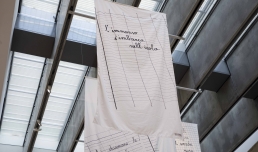
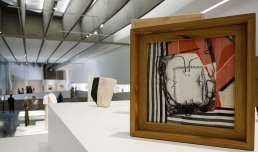

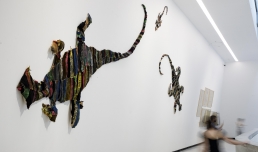


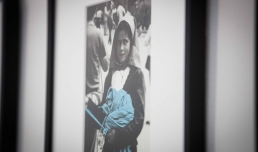

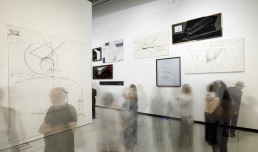


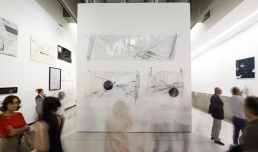

curated by Bartolomeo Pietromarchi, Luigia Lonardelli
in collaboration with Archivio Maria Lai and Fondazione Stazione dell’Arte
On the occasion of the centenary of her birth, MAXXI is dedicating a major exhibition to Maria Lai(1919-2013), one of the most unique characters of contemporary art in Italy, and her works have recently been displayed at Documenta 14 and the 2017 edition of the Venice Biennale.
A necessary tribute to a great artist who created a language in relational art made of sensitivity, local tradition and global codes.
Tenendo per mano il sole is the title of the exhibition and the first Sewn Fable made by the artist. Both the title and the work contain many of the elements typical of Lai’s research: her interest in poetry, language and the word; the cosmogony of her geographies evoked by the sun; the pedagogical vocation implicit in that “taking by the hand”. Not so much a classic retrospective as a story that is not bound by purely chronological constraints and follows a peculiar biographical and artistic path, characterised by discourses and intuitions apparently left suspended before being taken up again many years later.
Through a broad selection of works, many of them previously unseen, the exhibition presents the multifaceted world of Maria Lai and the dense stratification of ideas and suggestions that characterised her imaginary. The show is structured in five sections which take their name from citations or the titles of works by Lai, while the subtitle describes the typical methods of her research; the voice of Maria Lai accompanies each section through a montage of previously unseen material compiled by the director Francesco Casu. There is also a final section documenting the works of environmental art realised by the artist, in particular in the Ogliastra region.
Tenendo per mano il sole, 1984-2004, thread, fabric, velvet (detail). Private collection, Courtesy Archivio Maria Lai. Photo Francesco Casu © Archivio Maria Lai by SIAE 2019
SECTIONS
To Be Is to Weave. Sewing and Mending
Art is Adult’s Play. Playing and Storytelling
Landscape Object. Spreading and Sharing
The Astral Traveller. Imagining the Elsewhere
Art Takes Us by the Hand. Meeting and Participating
Maria Lai and the Ogliastra
Cataloghi della mostra
2019 exhibition’s catalogue
Holding the Sun by the Hand